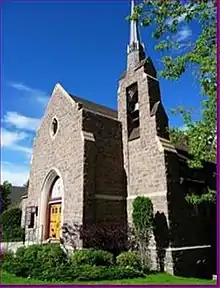St. Peter's Cathedral (Helena, Montana)
St. Peter's Cathedral is located in Helena, Montana, United States. It is the seat of the Episcopal Diocese of Montana. In 1990 the cathedral was added as a contributing property in the Helena Historic District.[3] In 2020, it reported 499 members, 133 average attendance, and $302,749 in plate and pledge financial support.
| St. Peter’s Cathedral | |
|---|---|
| The Cathedral Church of Saint Peter | |
 St. Peter's Episcopal Cathedral in Helena, Montana | |
| 46°35′33.03″N 112°02′23.23″W | |
| Location | 511 N. Park Ave. Helena, Montana |
| Country | United States |
| Denomination | Episcopal Church |
| Website | www |
| History | |
| Status | Cathedral |
| Founded | March 28, 1869 |
| Dedication | St Peter |
| Dedicated | March 27, 1932 |
| Architecture | |
| Functional status | Active |
| Architect(s) | Harold Whitehouse |
| Style | Gothic Revival |
| Groundbreaking | September 10, 1931 |
| Completed | 1932 |
| Construction cost | $90,000[1] |
| Specifications | |
| Materials | Stone |
| Administration | |
| Diocese | Montana |
| Clergy | |
| Bishop(s) | Martha Elizabeth Stebbins |
| Dean | Scott Crawford Anderson |
St. Peter's Episcopal Church St. Peter's Rectory | |
| Part of | Helena Historic District (ID90000934[2]) |
| Added to NRHP | June 14, 1990 |
History
The first Episcopal services were held in Helena on August 11, 1867 by Bishop Daniel Sylvester Tuttle and the Rev. E. N. Goddard. On March 28, 1869, Bishop Tuttle formed a Bishop's committee to establish an Episcopal mission in Helena; he celebrated Holy Eucharist in the courthouse. He paid $1,200 for property on Warren and Grand Streets to build a church, known as St. Peter's. A stone structure with a bell tower was completed for $12,000.[1] Holy Eucharist was first celebrated there on October 19, 1879, and the church was consecrated on November 11, 1881.
By 1920, St. Peter's was led by Rev. Sidney Douglass Hooker, originally from Watertown, New York, who was rector through the initial planning of the new cathedral. Fundraising for the present church building was begun 1927. Spokane, Washington architect Harold Whitehouse designed it in the English country Gothic style.[4] He also crafted a myrtlewood cross for the church. (He was elected as a Fellow to the American Institute of Architects for his work.[4])
The cornerstone was laid by Bishop William F. Faber on September 10, 1931. The stones for the cathedral were quarried in the Helena area.[5] The new St. Peter's Church was completed for $90,000 and dedicated by Bishop Faber on Easter Sunday, March 27, 1932.[1] The bell and brass altar from the first church were used in the new one. It was designated as the pro-cathedral for the diocese. In 1941, a residence for the dean was built next to the cathedral. It has subsequently become the Diocesan Offices, and it shares the cathedral's historic status.[3] St. Peter's left its cathedral status in the mid-1990s, but returned to it in 2004.[1]
Contemporary
St. Peter's served as a pro-cathedral until the mid-1990s, when it was redesignated as a parish church. It was re-designated a cathedral in 2004. Other buildings on the property included the deanery, completed in 1941 and now serving as the Bishop's Office, and Wilson Hall, an education building completed in 1959.
It hosts the Togendowagon Society, a Native American ministry. Togendowagon means 'awakening'. Father Ray Brown celebrates Eucharist with drums, with offerings of sweet grass and sage, on the 2nd and 4th Saturdays of each month except July and August, due to powwow season.
It stands opposite the Olsen House.
See also
References
- "About Our Founding". St. Peter’s Cathedral. Retrieved July 9, 2012.
- "National Register Information System". National Register of Historic Places. National Park Service. March 13, 2009.
- Chere Jiusto. "National Register of Historic Places Registration: Helena Historic District (Amendment)". National Park Service. Retrieved December 12, 2017.
- "Architect Harold Whitehouse Dies". Spokane Daily Chronicle. September 26, 1974.
- "St. Peter's Cathedral". Visit Montana. Retrieved July 9, 2012.